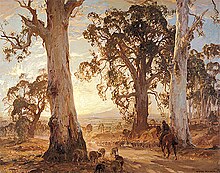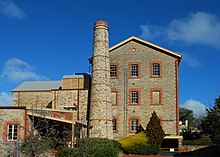Adelaide Hills
34°54′40″S 138°42′26″E / 34.911185°S 138.70735°E
| Adelaide Hills Federal division(s) | ||
|---|---|---|
The Adelaide Hills region is located in the southern Mount Lofty Ranges east of the city of Adelaide in the state of South Australia. The largest town in the area, Mount Barker is one of Australia's fastest-growing towns. Before British colonisation of South Australia, the area was inhabited by the Peramangk people.
The Adelaide Hills wine region comprises areas of the Adelaide Hills above 300 m (980 ft).
History

Before European settlement, the
The Adelaide Hills were among the first areas of South Australia to be settled by European settlers. A number of towns in the Hills were started as
This explains the strong German cultural connection seen in the number of

Culture and attractions
This article needs additional citations for verification. (June 2020) |




For many Adelaide residents, a drive through the hills is a popular pastime, particularly due to proximity to the city and other suburbs.[5] With Adelaide being a linear city extending 90 kilometres (56 mi) north to south, the hills are within 20 kilometres (12 mi) of the majority of residents.
The Adelaide Hills region is close enough to commute to the city, yet is the gateway to the country, so residents enjoy the best of both worlds – the country community life and the convenience of the city. Desirability of the area has increased, particularly since realignment of the road and construction of the Heysen Tunnels on the South Eastern Freeway improved road access. Rising real estate prices reflect this. The tunnels, completed in 1999 are named after Sir Hans Heysen, an eminent local landscape painter whose home and studio, "The Cedars", has been maintained as a cultural site located near Hahndorf. To this day, Hahndorf itself supports a thriving community of artists and craftspeople, either in the town or nearby countryside.
Wine region
The Adelaide Hills wine region includes all areas of the Hills above 300 m (980 ft). The elevation leads to cooler nights during the warm summer months, important for increasing the flavour of wines during the ripening season, and higher rainfall.[6]
The Adelaide Hills region is one of the oldest
Attractions
The
Gumeracha is home to the
The National Motor Museum is at Birdwood.[8]
Events
The National Motor Museum is the endpoint of the "Bay to Birdwood" event, in which up to 5,000 motor vehicles are driven by their owners from Glenelg past the city and through the hills to finish at the museum, a distance of 70 km (43 mi), where a festival is held. There are two Bay to Birdwood events held on alternate years: the Run, held on even-numbered years, for vehicles manufactured up to 31 December 1959, while the Classic, held on odd-numbered years, is for vehicles manufactured between 1 January 1956 and 31 December 1986.[8]
The Tour Down Under is a major annual sporting event, which makes use of some of South Australia's most popular cycling locations, including the Hills.[9]
The area is home to the annual Medieval Fair held at Gumeracha across one weekend every April, and the English Ale Festival, also annually held each May. Highlights of the Medieval Fair include live jousting tournaments held on horseback, blacksmithing and dance demonstrations, needlework and costume creation, and authentic music provided by wandering troubadours. The genesis and popularity of these two colourful festivals, where patrons are encouraged to come in costume, springs from the relatively large numbers of British expatriates who reside in the Hills.
Throughout the year there are
Protected areas

The Hills region includes the
Many native species of fauna can be encountered within the hills region. Among the more common species include the
Many walking trails, including a portion of the
Facilities
Sport and recreation
Sporting and recreational activities are also popular in the hills region, with sports such as
Media
A small independent weekly newspaper, The Courier, is published in Mount Barker and serves many Hills towns. Founded in 1880, the paper has never missed a print run. It has been in the hands of the same family, the Marstons, since 1954, with a circulation of 7,500 as of May 2020, down from 15,000 in its heyday in the 1970s and 1980s.[10]
Climate

It is generally a few degrees cooler in the Hills than in
The area receives a light snowfall approximately once every three to four years, occasionally enough to stay on the ground for half a day,[citation needed] and large amounts of hail are more likely to fall here than on the Plains.[11]
See also
- List of towns in the Adelaide Hills
- South Australian food and drink
- South Australian wine
- Ecotourism
References
- ^ Australian Bureau of Statistics (27 June 2017). "Adelaide Hills (DC)". 2016 Census QuickStats. Retrieved 4 May 2018.
- ^ Australian Bureau of Statistics (27 June 2017). "Mount Barker (DC)". 2016 Census QuickStats. Retrieved 4 May 2018.
- ^ "Adelaide Hills (South Australian Government Regions)" (PDF). Department of Transport, Planning and Infrastructure. Retrieved 16 May 2015.
- ^ "Peramangk". Visit Adelaide Hills. Retrieved 5 July 2021.
- ^ My Backyard: Adelaide Hills Archived 15 September 2015 at the Wayback Machine, InDaily, 8 August 2015. Accessed 9 January 2016.
- ^ "Climate - South Australia". Adelaide Hills Wine Region. Retrieved 28 October 2021.
- ^ Bishop, Geoffrey (12 June 2015). "Viticulture". Adelaidia. Retrieved 28 October 2021.
This entry was first published in The Wakefield companion to South Australian history edited by Wilfrid Prest, Kerrie Round and Carol Fort (Adelaide: Wakefield Press, 2001). Edited lightly. Uploaded 12 June 2015.
- ^ a b "About". Bay to Birdwood. Retrieved 28 October 2021.
- ^ Hills, Our Adelaide. "South Australia's best Cycling locations". Our Adelaide Hills. Retrieved 11 July 2019.
- ^ Adams, Prue (28 May 2020). "As coronavirus shuts down regional news, this 91-year-old Adelaide Hills newspaper editor keeps printing". ABC News. Australian Broadcasting Corporation. Retrieved 1 June 2020.
- ^ Boisvert, Eugene (29 September 2021). "Hail and heavy rain hit Adelaide and the Adelaide Hills as storms roll through South Australia". ABC News. Australian Broadcasting Corporation. Retrieved 28 October 2021.
